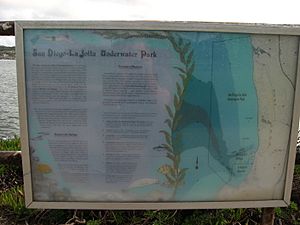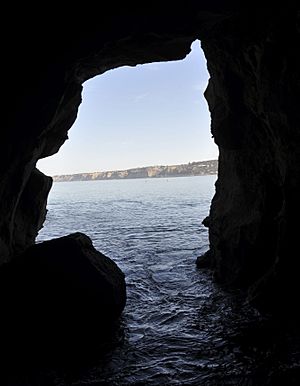San Diego-La Jolla Underwater Park facts for kids
The San Diego-La Jolla Underwater Park is a special ocean area. It covers about 6,000 acres (24 square kilometers) of ocean floor and coastal lands. This park is famous for its four different natural areas: rocky reefs, kelp forests, sandy flats, and deep underwater canyons. These amazing habitats make it a favorite spot for people who love to snorkel and scuba dive. The City of San Diego created this park in 1970. Inside it, there are two other protected areas: the Ecological Reserve and the Marine Life Refuge.
The underwater park also has two artificial reefs. These are human-made structures placed in the ocean to attract and help marine life grow. The first reef was built in 1964. It used rocks from a quarry and was placed about 70 feet (21 meters) deep near Scripps Canyon. The second reef started in 1975. It is about 40 feet (12 meters) deep, just off the coast from Black's Beach.
Near La Jolla Shores, the ocean floor gently slopes down into the sea. The reefs here help keep the waves small. This makes it a great place for divers and kayakers to enter the water. Farther out, large kelp beds grow. These are popular places for fishing and for watching seals, dolphins, birds, and many kinds of fish.
Beyond the gentle slope, the ocean floor suddenly drops very deep. This is the La Jolla Canyon, which plunges about 500 feet (152 meters) down. Within the park, the canyon can reach depths of 600 feet (183 meters). This sudden deep drop and the many sea creatures explain why migrating whales are often seen close to the shore here.
In 2008, a large map of the underwater park was finished. It is 30 feet (9 meters) by 75 feet (23 meters) and made of a special material called lithocrete. You can find this map at La Jolla Shores beach. It is near the boardwalk, between the restrooms and the children's play area at the south end of Kellogg Park.
Protecting Ocean Life: Reserves and Refuges
The Ecological Reserve was created in 1971. It has grown to cover about 533 acres (2.2 square kilometers). This reserve includes all of La Jolla Cove and part of the La Jolla Shores beach. In this special area, you are not allowed to fish or collect anything from the ocean. It's a "look but don't touch" zone for marine life.
The Marine Life Refuge is another protected area. It includes the Scripps Pier at Scripps Institution of Oceanography. This refuge was set up way back in 1929 for scientific research. Unlike the Ecological Reserve, you are allowed to enjoy recreation and fishing in the Marine Life Refuge.
The Amazing La Jolla Caves
The seven sea caves in La Jolla are carved into a very old sandstone cliff. This cliff is about 75 million years old! These seven cave openings all face north. They are located between the beaches of La Jolla Shores and La Jolla Cove. The seven sea caves have unique names, from west to east: The Clam’s Cave, Sunny Jim’s Cave, Arch Cave, Sea Surprize, Shopping Cart, Little Sister, and White Lady. Most of these caves can only be reached by kayak.
Sunny Jim’s Cave is the only La Jolla cave you can visit by land. You go down a hand-dug tunnel from a historical building called The Cave Store. The famous author of The Wizard of Oz, Frank Baum, gave the cave its name, "Sunny Jim." He thought the cave's opening looked like a cartoon character from a 1920s cereal box.
For many years, people have been drawn to the seven caves of La Jolla. Long ago, people used the tunnel to secretly bring in goods. Today, many visitors come to "The Cave Store." The cave opening has been cared for and protected for over 100 years. The old Crescent Café, now The Cave Store, is at 1325 Coast Boulevard in La Jolla.
The Clam’s Cave is the only sea cave you can see from land. It has two sides, and you can see the back from Goldfish Point on Coast Boulevard. The other La Jolla caves are usually covered by waves. So, they are mostly seen by kayakers. White Lady cave is named because its shape looks like a long dress. It is on the eastern side of the cliff. Many large rocks in front of White Lady cave cause waves to crash and create white foam. This is why it is called "White Lady."
Fishing Around the Park
While the underwater park itself used to be a very busy fishing spot for lobster, abalone, and many types of fish, the areas just outside the park boundaries are still popular for fishing. Many people who fish here practice "catch and release." This means they catch the fish and then let them go. The kelp beds outside the park are also great spots for fishing.
32°51′09″N 117°16′03″W / 32.8525°N 117.2674°W




